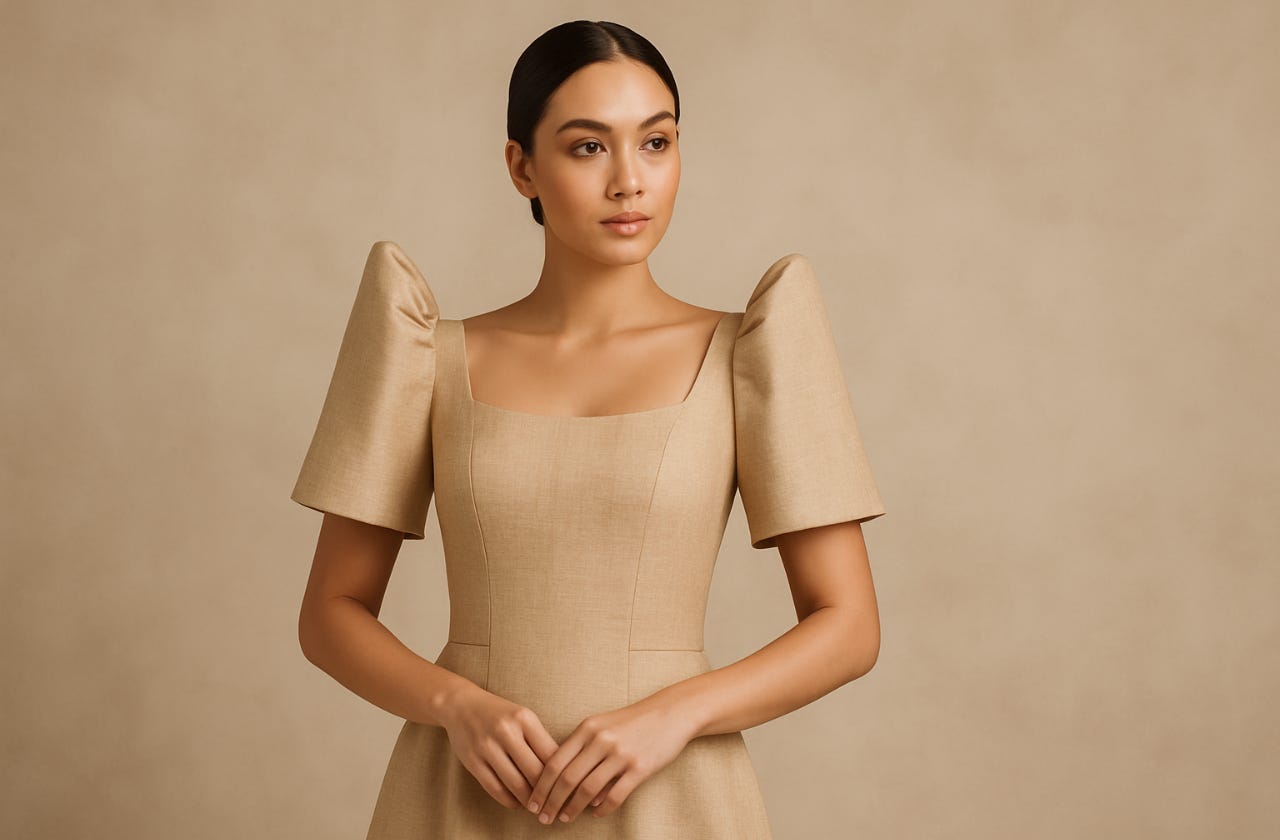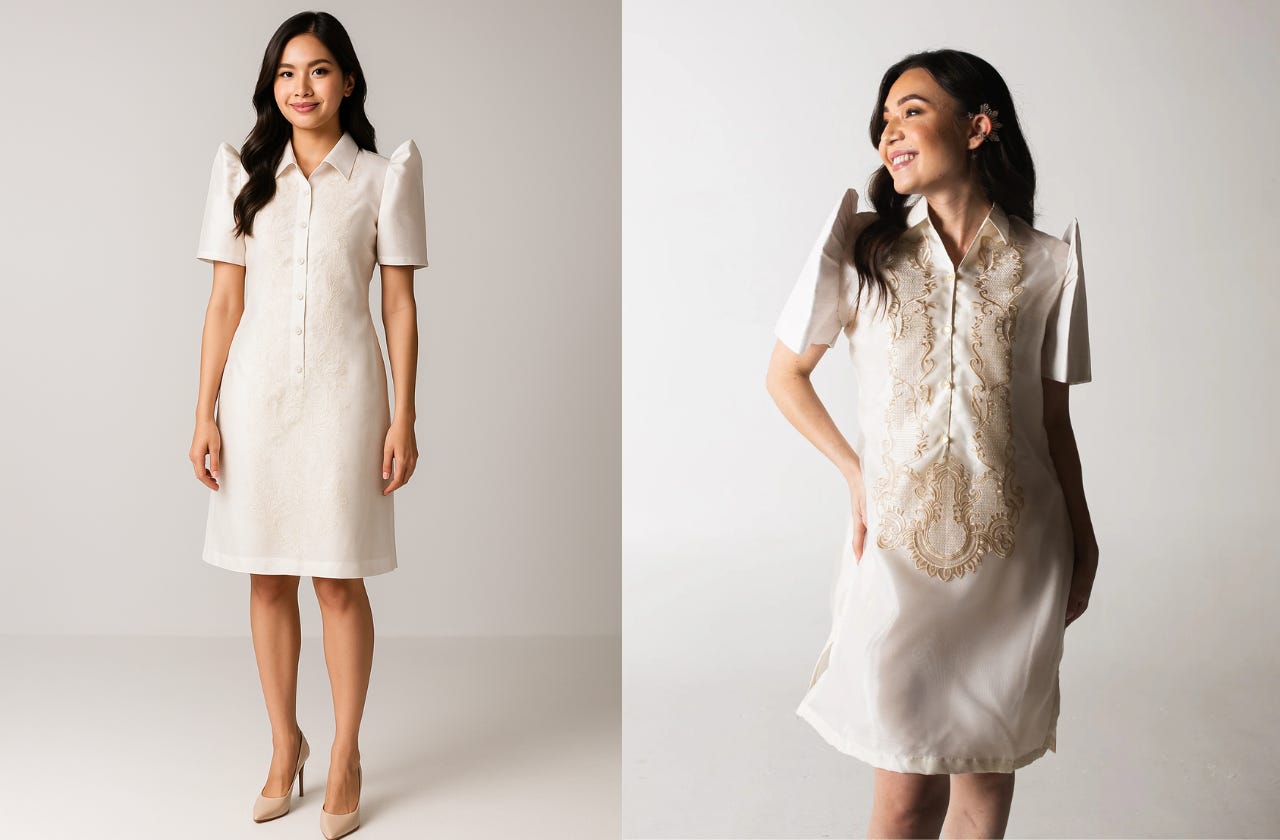The Filipiniana
It’s not just a dress. It's our heritage.
I’ve always had a complicated relationship with the Filipiniana dress. I remember seeing my Filipino teacher at school events, such as Buwan ng Wika (Filipino Language Month) and graduation ceremonies. Those elegant but intimidating butterfly sleeves sparked a smile on my face.
To me, the Filipiniana always felt like a time capsule, a beautiful piece from the past. That was, until I saw a famous Filipina model on Instagram wearing a crop top with those iconic terno sleeves, paired with high-waisted jeans. In that moment, I knew that the Filipiniana is timeless and cool.
Back in high school, I remember that Filipino and history subjects were one of the most important parts of the curriculum. You have to study the Filipino language and memorise the story and death of Jose Rizal (our national hero). Which, of course, includes Noli Me Tángere, one of his notable novels.
Maria Clara
Maria Clara is one of the lead characters of Noli Me Tángere, and upon re-reading it, she is portrayed as an ideal symbol of a Filipina, yet also a suppressed and passive woman during her time. Some critics even presented her as an unattainable and harmful ideal of a Filipino woman.
Fast forward to today and these kinds of criticism and description of a woman are aggressive and debatable these days, where women, despite their behaviour and history, are celebrated.
The Filipiniana is one of the most fascinating and remarkable topics in Filipino history. These days, it’s trending. You’ll see it at graduation events, weddings, birthday parties, beauty pageants, diplomatic, political and social gatherings. However, it was once a privilege and a symbol of classic femininity. While elegant fashion can be timeless, I also see it as a representation of history.
Women Who Broke the Mold
While Maria Clara was the ideal woman on paper, the real Filipinas of that time were already forging their own paths.
Consider Clemencia López, an activist and suffragist in the early 1900s who travelled to the United States to advocate for Philippine independence. She was a woman of intellect and conviction, and she utilised her Filipiniana as a symbol of Filipino civilisation and dignity within a colonial context.
Learning about women like Clemencia made me realise that the Filipiniana was never just about being demure. It was an attire for women who were intelligent, brave, and determined to make a difference in the world. It makes me reminisce about the image of my high school teacher with a new kind of respect.
The Modern Filipiniana Woman
Today, that spirit of resilience is more visible than ever. The modern Filipiniana isn’t just a trend, it’s a badge of honour worn by a new generation of Filipinas who are reclaiming their heritage.
I have noticed that women politicians often wear Filipiniana attire in social and political events. Social media content creators, beauty queens, and TV news anchors use the dress not as a symbol of submissiveness, but as a powerful statement of national pride and strength.
They’re wearing it to represent their cultural pride in a global space, showing that heritage and modernity are not mutually exclusive. This is thanks in no small part to the incredible work of Filipino designers who are celebrated for their amazing work, from honouring the traditional Saya to giving it a fresh, modern twist.
Ramon Valera, often called the “King of Philippine Fashion,” and the first Philippine National Artist for fashion, was the one who took the separate pieces of the baro’t saya and made them into the one-piece Terno we know today. His work is a cornerstone of Filipiniana fashion.
Designers like Francis Libiran, known for his clean lines, and Rajo Laurel, celebrated for his bold colours and creative use of materials, continue to reinvent the classic Filipiniana for the modern woman.
And Len Cabili’s Filip+Inna designs focus on preserving the weaving traditions of different indigenous communities, making her work both visually stunning and culturally significant.
I know what you’re thinking…is “Filipiniana“ just one dress? Like me, you’ve probably only seen it from a distance, maybe in old photos or during formal events. I’ll be honest, writing this is a little sensitive and challenging for me. I’ve never actually worn one in my life, though I came close.
I desperately wanted to wear one for my college graduation, but I couldn’t find the one I really liked that fit me in Melbourne, Australia. Asking someone to bring one all the way from the Philippines just wasn’t possible and would have been too much for a last-minute request. It’s still a dream of mine to wear one someday, maybe even design my own or get inspiration from other designers.
The Evolution of the Filipiniana Dress
Let’s time-travel to explore the evolution of Filipiniana and its diverse forms. It’s a captivating narrative of how a single dress has evolved into a multitude of styles, each with its own unique story. This exploration will surely enlighten you about the rich history and transformation of Filipiniana.
● Baro’t Saya. Let’s begin at the origin. Baro’t says translates to ‘blouse and skirt,’ was a simple, two-piece outfit that predates the colonisation of our country. The baro, a light and often slightly see-through blouse, paired with the saya (a simple wrap-around skirt), was the everyday wear for Filipina women. Its practicality, comfort, and elegant simplicity are aspects of its design that we can all appreciate.
● Maria Clara Gown: A literary icon, it gained popularity during the Spanish colonial period and is perhaps the most famous Filipiniana, thanks to Rizal’s novel. It transformed the simple Baro’t Saya into a more formal and ornate attire. This version, with its additional pieces, a stiff, triangular pañuelo and a hip-hugging overskirt called the tapis, became a symbol of the wealthy, aristocratic Filipina. Its traditional yet imposing design carries a significant historical weight.
● Terno: The Modern Classic. This is the Filipiniana most of us recognise today, the one you’ll see at weddings and graduations. The Terno simplified the Maria Clara gown into a single, seamless dress. Its defining feature is those bold, butterfly sleeves that stand straight up, giving the wearer a powerful silhouette. The cumbersome pañuelo and tapis were removed for a cleaner, more modern look. It’s the perfect choice for a grand entrance and a true testament to how fashion adapts.
Fun fact: The Terno has graced the international stage, adorning Filipino celebrities and beauty queens. Miss Universe 2018 Catriona Gray, for instance, donned a Terno-inspired outfit by designer Mak Tumang for her homecoming parade after winning the crown.
Inspired by the sampaguita, the national flower, the dress with its intricate design and powerful silhouette was a stunning homecoming for the queen, capturing everyone’s attention. This is a testament to the global appeal and pride in Filipiniana fashion, a heritage with which we can all take pride.
My dream of wearing a Filipiniana is a dream of connection to my heritage, to the women who came before me, and to the powerful legacy they built. This is a garment that has evolved with the Filipina, from being a symbol of quiet dignity to a bold declaration of pride. It’s a journey we’re all still on.
Whether you’re looking for a ready-to-wear piece or a custom-made gown, finding your own connection to this heritage is easier than ever. Popular places to check out include Kultura Filipino, a great place for everyone, from tourists to locals, and Casa Barong Filipiniana, which specialises in custom pieces using traditional fabrics.
For a more modern, everyday feel, brands like Tygie and Vinta Gallery are pushing the boundaries of what traditional attire can be. And for a huge selection, Barong World is a popular online choice for people all over the world.
What about you? Is wearing a Filipiniana a dream? Tell us your story!









What a wonderful article!!! Thank you very much.